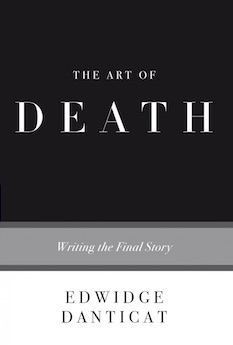Shortlisted for the 2018 Christian Gauss Award
By D.T. Siebert
In The Art of Death: Writing the Final Story, Edwidge Danticat explores how selected writers have treated life’s final scene. For such a short book, Danticat’s references are many and varied—from the Bible, Dante, and Montaigne; to the recent past, such as Tolstoy, Chekhov, Camus, Hemingway, and Dylan Thomas; and on to more contemporary writers, such as Anne Sexton, Garcia Marquez, Toni Morrison—Danticat herself of course—and many others. A substantial part of the book consists of a back-and-forth pattern: Danticat interprets key passages by other writers and then relates those quotations to her own experience, especially in witnessing her father’s, her uncle’s, and finally her mother’s death. This participation in her family’s dying was difficult for her, but most traumatic of all was her mother’s long and slow dying—an experience that appears like a leitmotif throughout the book—and assumes the primary focus of the final sections.
Danticat was born in Haiti and grew up there. She recalls her earlier life in that troubled country, a life which was always unpredictable and often dangerous. She describes the comforting, stabilizing customs and folklore of “ars moriendi” (the art of dying) in the Haitian and Southern African-American cultures. Customs and ceremonies make up fine art, too. And she often quotes French-Haitian Creole when remembering her mother, who spoke it all the time:
“Nou tout a p mache ak sekey nou anba bra nou,” my mother had been casually saying for years. “We’re all carrying our coffins with us every day,” or “We are all constantly cheating death.” This is how I usually translated that Creole phrase to her doctors and nurses whenever she asked me to, usually after they had tried to reassure her, during some agonizing diagnosis or another debilitating chemotherapy session, that everything was going to be okay. “Media vita in morte summus,” “In the midst of life, we are in death.”
Here Danticat blends the Latin line in a Gregorian Chant with the way of saying the same thing in Creole, then variously in English—a fine creative stroke, indeed. Living and dying are the same, no matter the language. But one’s native tongue affirms a special bond of closeness and affection: “’I love you,’ I told her over and over in Creole. ‘Mwen renmen ou.’ I held her hand, I kissed her face . . . .” Another effective detail in the passage above is the ironic contrast between ordinary human wisdom and scientific knowledge. Human wisdom bids one to accept the inevitable, whereas medical science tries to defeat death, regardless of such an effort’s ultimate futility—and the prolonged suffering that futile effort causes. Who is the wiser—the dying woman or her physicians?
The Art of Death has many merits. It is often very moving, and the reader never doubts Danticat’s sincerity, nor her ability to interpret the passages she quotes, focusing on their emotional center. These other accounts become one with her own memoir, just as it is being written. Thus her book illustrates the very art she has been examining—the art created by dying and death.
The Art of Death’s only weakness is its lack of structure and a clearly stated purpose. The book consists of many good parts that never quite get put together. What is the argument or overall point of all these individual parts? Tellingly, the book has no chapters but rather textual breaks, each with a heading that only loosely fits what follows. One break title is “Circles and Circles of Sorrow,” which might just as well describe the whole book’s method, or lack of method, or even be its subtitle. As Danticat notes, substantial portions of her book have previously appeared in other publications. This fact might account for the piecemeal content of the whole book. Two of the final sections—dealing mainly with the last stages of her mother’s dying—are quite effective because they are the most intense and focused ones.
Danticat’s purpose—even if never clearly stated or emphasized—seems to resemble my own in a recent book (see below). How can art make sense of dying and death? How can art help us come to terms with the inevitable end of life? Perhaps nothing can, yet our human nature urges us to try. Art attempts to give shape and form to the experience of dying—thus asserting a kind of control over it. Art strives to give death a possible meaning or even beauty, even if, in the words of W.B. Yeats, it is a “terrible beauty.” Or likewise in that paradoxical claim of Wallace Stevens: “Death is the mother of beauty.”
D.T. Siebert (Phi Beta Kappa, University of Oklahoma, 1962) is Distinguished Professor Emeritus of English Literature at the University of South Carolina. Recent publications include Mortality’s Muse: The Fine Art of Dying (Delaware, 2013) and the chapter “David Hume and the History of England” in the Oxford Handbook of Hume (Oxford, 2016).




